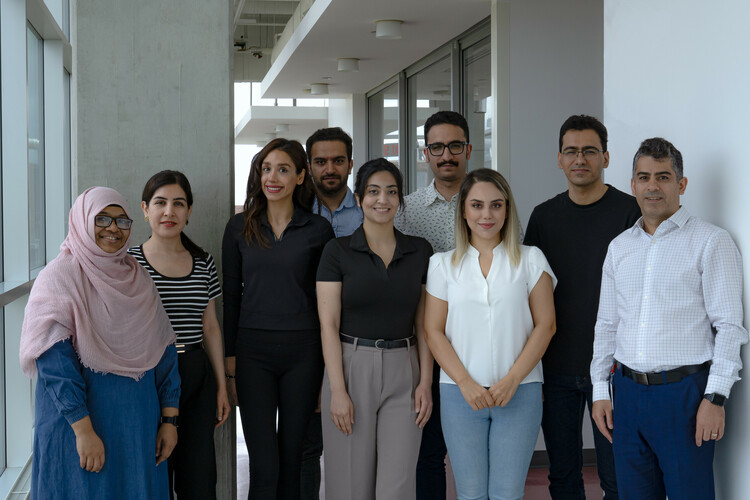Accelerating Water Treatments: Optimizing Membrane Technology for Contaminated Water Treatment
Posted on
Dr. Mohtada Sadrzadeh and the Advanced Water Research Lab team
“We’re situated at the intersection of clean water security, energy security, and climate, focusing on how these interact and shape our environment and systems,” says Dr. Mohatada Sadrzadeh.
Mohtada runs the Advanced Water Research Lab (AWR Lab), a research group based in the University of Alberta’s Mechanical Engineering Department, which addresses challenges at the energy-water-climate nexus. The AWR Lab specializes in developing high-performance membrane materials and processes for the treatment of contaminated water. His research works closely with in situ oil sands extraction and, in particular, steam-assisted gravity drainage (SAGD).
Industrial operations like SAGD use very large amounts of water under high-temperature and high-pressure conditions. Ultimately, Mohtada’s goal is to help optimize industrial water treatment processes using advanced membranes that can recycle, treat, and reuse the water in this process, allowing industry to use less energy and less freshwater.
“Improving energy efficiency means less greenhouse gas emissions,” Mohtada explains. “We need membranes that function for long periods, in various industrial settings, and with minimal economic costs.”
A Membrane with Many Functions
Mohtada compares the AWR lab’s membranes to the drain catcher under your kitchen sink.
“The filters inside the device catch small food bits, grease, or anything that isn’t water,” he says. “Our membranes are similar; they catch particles and remove contaminants as water passes through the filtration system.”
However, the membranes aren’t one-size-fits-all and need to be customized, as material composition and pore size both vary based on the intended application. Depending on the filtration needs, which include microfiltration, ultrafiltration, nanofiltration, and reverse osmosis, the membranes’ pore sizes range from 1000 nanometers to less than a single nanometer.
“Different industries require different treatment solutions,” Mohtada says. In residential applications, we may target bacteria or viruses, so silver-based antimicrobial materials are preferred. In agriculture, we’re focused on removing pesticides and organic matter, which calls for different materials altogether.”
Membranes can be made from polymers, metals, ceramics, and even biopolymers sourced from keratin found in chicken feathers. Across campus, Mohtada is also collaborating with Dr. Aman Ullah and Dr. Tariq Saddique on developing membranes that combine technologies from both labs: low-pressure advanced membranes made from lignins and adsorption technologies stemming from Dr. Ullah’s chicken feather keratin-based biopolymers.
Assessing an Advanced Membrane
In the lab, Mohtada’s team characterizes each membrane to assess its separation performance, hydrophilicity (measured by the water contact angle), surface charge, and chemical composition through advanced spectroscopy and microscopy techniques.
Afrouz Yousefi, a PhD candidate with the AWR Lab, explains how these variables affect the membrane’s function: “We usually want an angle of less than 60 degrees for clean water treatment. That indicates that the membrane’s surface is hydrophilic, which means that more water can pass through. But in applications like membrane distillation, we prefer a membrane with hydrophobic surface, with angles greater than 90 degrees.”
While the angle of contact changes how much water passes through a membrane, Mohtada’s team discovered that changing the surface charge is another way to adjust a membrane’s function.
“Most contaminants have a negative charge, so we learned to add a positive charge to the membrane’s surface,” Mohtada adds. “Like a magnet, the negative and positive charges will attract each other and more contaminants are removed.”
Adding a surface charge also reinforces the anti-fouling properties of the membranes––for instance, reducing the ability to prevent bacteria or organism growth on a surface––which ultimately extends the lifespan of the prototype membrane.
“Some membranes need to last for up to three years under extreme conditions, and they can’t afford to lose any functional properties during that time,” Mohtada adds.
Trickling into Commercialization
In 2024, Mohtada was successful in his application for the FES Accelerator Fund, which was created to launch near-market-ready research into successful commercialization. The AWR Lab is currently working at the advanced level of production on their first prototype (a model measuring 1.8-inches in diameter and 12-inches in length) and are in the process of developing a second (sized at 2.5 inches in diameter and 21 inches in length).
A significantly bigger filter will be required for water treatment at the industrial scale of SAGD operations—one that measures 4-inches in diameter and 1-metre in length. By partnering with industry and other academic partners, Mohtada and the AWR Lab have been able to accelerate their research and development to more rapidly move their membranes into the commercial market.
“We’ve been fortunate to partner with Pathway Alliance, Suncor Energy, and Canadian Natural Resources Limited (CNRL) to begin upscaling and testing this technology at pilot scale,” Mohtada shares. He also acknowledged support from the National Research Council (NRC), Natural Resources Canada (NRCan), and Future Energy Systems (FES).
Moving forward toward commercial implementation of the membranes, Mohtada explains that reducing material costs will be a priority for his team: “While we’ve found that advanced nanomaterials are really good for enhancing membrane properties, they’re still mostly quite expensive, which is a challenge for businesses and industry. We’re exploring more economic options such as waste or byproducts or other industries, such as lignin from the pulp and paper industries and carbon from methane pyrolysis processing.”
“Water shortages can and do happen in more places than far away deserts,” Mohtada concludes. ”We need to be prepared for that reality.”
At the AWR Lab, Mohtada and his research team develop advanced membranes from a multitude of materials with properties designed for innovating contaminated water treatment technology. But they’re also helping advance sustainability in our energy, water, and climate futures.
Watch Dr. Mohtada Sadrzadeh’s interview about this research on Future Energy System’s YouTube Channel - Optimizing Low-Pressure Membrane Technology for Contaminated Water Treatment | Accelerator Project
This story is part of Future Energy System’s Accelerator Project Series. For more information on the Accelerator Projects, click here. To stay up to date with this series, subscribe to our monthly newsletter and follow FES on social media.